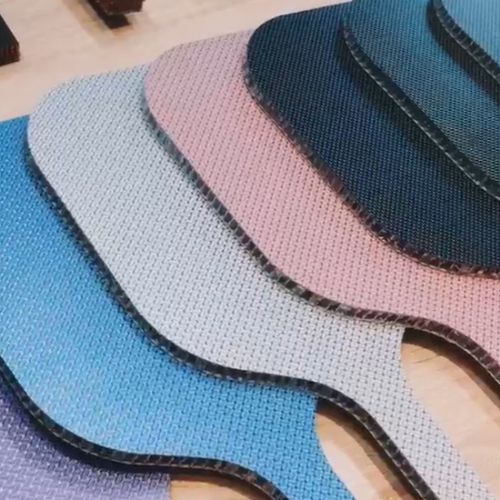Pickleball is sweeping across courts worldwide, drawing players in with its dynamic gameplay. But did you know that the key to mastering this sport lies in your choice of paddle? Just as a knight wields a sword tailored to their fighting style, your pickleball paddle can determine your on-court prowess.
In this guide, we’re diving into the world of pickleball paddles. If you’re a beginner, you might wonder, is there really a difference between pickleball paddles? More experienced players will tell you that the grip, weight, and other factors actually can affect your plays.
Whatever your level of expertise is, let’s get ready to uncover the differences in pickleball paddles and choose the right one for you.
Understanding Pickleball Paddles
There are several brands available on the market, so what is the difference between pickleball paddles? Well, let’s start with the basics.
What Are Pickleball Paddles Made Of?
The key components that shape a pickleball paddle are the front side of the paddle that makes contact with the ball, called the paddle face, and the interior of the paddle that gives it structure and responsiveness, called the core. Paddles are created from different materials, each offering unique characteristics.
Here are some of the most common materials used in pickleball paddle faces:
- Composite (Fiberglass): Fiberglass and polymer materials are combined to deliver a balance of power, control, and durability. Among all the materials, composite offers the most power.
- Graphite: Graphite paddles are known for their lightweight nature and excellent maneuverability. They’re often preferred by players who value finesse and quick reactions.
- Wood: Traditional and favored by some players, wood paddles offer a classic feel and can be great for beginners. However, they may be heavier compared to modern alternatives.
- Other Materials: Paddles made from aluminum and carbon fiber offer distinct playing experiences, catering to specific preferences. While carbon fiber is known for having a better feel than fiberglass, it’s quite stiff, so it’s not as powerful.
Other Characteristics that Affect Your Pickleball Paddle’s Performance
Aside from the materials that make up a pickleball paddle, other characteristics can affect your gameplay, such as:
-
- Weight: The weight of your paddle affects the power you can generate with each swing, and how quickly you can react to your opponents. Heavier paddles offer more power, while lighter ones provide greater maneuverability.
- Size: Paddles with wider faces offer a larger sweet spot, increasing your chances of hitting clean, consistent shots. Narrower faces have smaller sweet spots, but they provide a longer reach.
- Grip: Your grip influences your control over the paddle. A comfortable grip size ensures proper handling and reduces the risk of injury.
- Texture: The surface texture of a paddle affects how it interacts with the ball. A rough texture can help generate spin, while a smoother surface offers more control.
- Thickness: Thicker paddles typically have a larger core and, therefore, more mass, which results in more power behind your shots. On the other hand, thinner paddles often have a more balanced weight distribution, which means a more balanced feel in your hand and during swings.
Now, given all this information, how do you choose the right pickleball paddle for you?
Factors to Consider When Choosing a Pickleball Paddle
There is no one-size-fits-all answer to a pickleball paddle’s ideal weight, size, shape, and grip style. But here are a few things to consider when choosing a pickleball paddle:
1. Weight and Balance
The weight of your paddle can significantly impact your gameplay. As mentioned earlier, heavier paddles can deliver more power behind your shots, making them ideal for players who prefer aggressive playstyles. Conversely, lighter paddles offer greater maneuverability, allowing quicker reactions and finesse shots.
Balance refers to how the weight is distributed within the paddle. A well-balanced paddle enhances your control and power. Paddles are often categorized as head-heavy, head-light, or evenly balanced. Players seeking power might lean towards head-heavy paddles, while those valuing control may opt for a more balanced distribution.
A slightly heavier paddle (around 8.5 to 9.5 ounces) with a head-heavy balance might be suitable if you’re an aggressive player who relies on powerful shots. For players who prioritize control and quick reactions, a lighter paddle (around 7.5 to 8.5 ounces) with a more balanced distribution would be better.
2. Paddle Size
The size and shape of your pickleball paddle influence your reach, sweet spot, and overall comfort. Pickleball paddles vary in size, with standard dimensions defined by the sport’s regulations.
If you’re a beginner or prefer a larger sweet spot, consider paddles that are closer to the maximum allowed size (15.5 inches long and 8.5 inches wide). Experienced players who value control might opt for slightly smaller paddles within the standard size range.
3. Paddle Shape
Most paddles are rectangular, but they can also be oval-, diamond-, tear-shaped and more. Here’s an overview of what you can expect from different paddle shapes:
- An oval-shaped paddle could be a good choice if you’re an all-around player, as it offers a balanced combination of power and control.
- Rectangular paddles suit aggressive players seeking power.
- Rounded or teardrop shapes give finesse players better control and maneuverability.
- Diamond shapes offer power, although they may sacrifice a bit of control, especially during softer shots and finesse play.
4. Grip Size
Your grip not only affects your comfort but also your ability to wield the paddle effectively. Grip size plays a vital role in preventing injuries and optimizing your play. A grip that’s too small can strain your hand and wrist, while one that’s too large can limit your control over the paddle. Finding the right grip size ensures a comfortable hold and reduces the risk of overuse injuries.
Grip size is highly individual and depends on your hand size and personal comfort. As a general guideline, hold the paddle with a relaxed grip and have about a finger’s width of space between your fingertips and palm. If you find yourself squeezing too tightly, the grip is too small, and if you struggle to maintain control, it might be too large.
5. Grip Style and Material
The grip style and material you choose depends on your comfort and moisture absorption needs. Overgrips are great for players who want to customize grip thickness, while cushioned or perforated grips can offer extra comfort and help manage sweat during intense matches. Experiment with different styles to find the one that suits you best.
6. Cost
While choosing a pickleball paddle that suits your style and preferences is essential, your budget is also a significant factor that can impact your decision. Note that the cost can vary significantly depending on the brand, technology, and design. This is just to give you an idea of how much each category is priced:
- Entry-level Paddles
Price range: around $30-$50
These paddles are often targeted at beginners or casual players. They might have basic designs and materials but can still provide a decent playing experience.
- Mid-range Paddles
Price range: around $50-$100
This category includes various paddles that balance price and performance well. Mid-range paddles often have more advanced materials, features, and technologies, making them suitable for intermediate players and those looking to step up from entry-level options.
- High-end Paddles
Price range: above $100
High-end paddles are designed for serious players who value premium materials and specialized features. These paddles are often associated with well-known brands and might cater to specific playing styles. They are typically favored by competitive players striving for exceptional performance.
If you want to start canvassing on different pickleball paddles, some of the most popular and trusted brands are from Selkirk, ONIX, Wilson, Franklin Sports, Paddletek, and Engage Pickleball. It is also important to note that the lifespan of a pickleball paddle is typically about one to five years, but this depends greatly on how often you play and how well you care for your equipment. Make sure to properly take care of your pickleball paddle to prolong its lifespan so you can get more plays out of it.
REMEMBER: These are just general guidelines and starting points. The ultimate choice should be one that aligns with your unique playing style, skill level, and personal preferences.
Finding The Perfect Paddle For Your Style
Pickleball is a game of diverse strategies and approaches, and your choice of paddle can greatly amplify your strengths on the court. Let’s dig into how different playing styles and skill levels can help you find the paddle that suits you best.
A Few Distinctive Styles:
- Power Players
These players focus on delivering commanding shots that test their opponents’ limits. To enhance their game, power players benefit from paddles with a solid core for added power and a slightly larger sweet spot to accommodate their forceful swings. Power players might benefit from paddles with a slightly larger paddle face, providing a larger sweet spot for those aggressive shots.
- Finesse Players
Precision and delicate control define the finesse style. These players rely on well-placed shots and smart placement rather than brute force. For finesse players, lighter paddles with a balanced weight distribution offer the maneuverability and control needed for accurate shots.
- All-around Players
These versatile players blend power and finesse, adapting their approach as the game demands. An all-around player might opt for a paddle that balances power and control, with a moderate weight and balanced distribution.
Assessing Skill Level
Your skill level is also pivotal in selecting the right pickleball paddle. Here’s how to match your paddle with your skill development:
If you’re new to pickleball, prioritize a paddle that’s forgiving and easy to control. A larger sweet spot and balanced weight can help you get comfortable with the game’s basics.
- Intermediate Players
As your skills progress, consider a paddle that aligns more closely with your chosen playing style. Experiment with slightly more specialized paddles to refine your strengths.
- Advanced Players
Seasoned players often seek paddles tailored to their well-defined styles. Fine-tune your paddle choice based on the nuances of your game to gain a competitive edge.
By considering your playing style and skill level, you can pinpoint the paddle characteristics that will elevate your game. With the right paddle, you’ll be well-equipped to conquer the court with finesse, power, or a balanced combination of both.
Pickleball Paddle Decision-making: A Checklist
At this point, you’re probably saying: this is too much information! But you need to be aware of the several factors to consider when choosing the perfect pickleball paddle. After all, knowledge is power!
Checklist
Here’s a checklist to guide you for easier decision-making! Use this sample list to navigate through the options and find the paddle that suits you best.
- Determine Your Playing Style. Are you a power player, a finesse player, or an all-around player? What are your strengths and weaknesses on the court?
- Assess Your Skill Level. Are you a beginner, intermediate, or advanced player? Think about how much you’ve progressed and where you aim to be.
- Set a Budget. How much are you willing to invest in a paddle? Keep in mind that quality and features often correlate with price.
- Identify Must-have Features. What characteristics are crucial for your playing style? Consider weight, balance, size, grip, and materials.
- Test Grip Size. Hold different paddles to find your comfortable grip size. Ensure you can maintain a relaxed yet controlled grip.
- Consider Paddle Weight. Determine whether you prefer a lighter or heavier paddle. Think about how weight affects your power and control.
- Select Paddle Size and Shape. Choose a size and shape that aligns with your playing style. Consider the sweet spot, reach, and maneuverability.
- Research Paddle Materials. Understand the differences between composite, graphite, wood, and other materials. Determine which material complements your desired performance characteristics.
- Read Reviews and Seek Recommendations. Research paddles that match your preferences and criteria. Read player reviews and gather insights from fellow players.
- Test Paddles Whenever Possible. If available, try out paddles before purchasing. Pay attention to how the paddle feels during swings and shots.
- Balance Quality and Price. Consider the long-term value of the paddle to its cost. Choose a paddle that offers the features you need without overextending your budget.
- Adaptability and Skill Progression. Consider how your playing style and skill level might evolve. Think about whether the chosen paddle can accommodate changes in your game.
Conclusion
The right paddle is your secret weapon. As you step onto the court armed with newfound knowledge, remember that the paddle isn’t just a tool—it’s your ally. Guided by the decision-making framework, you’re poised to unlock your potential, one perfectly suited swing at a time.




































